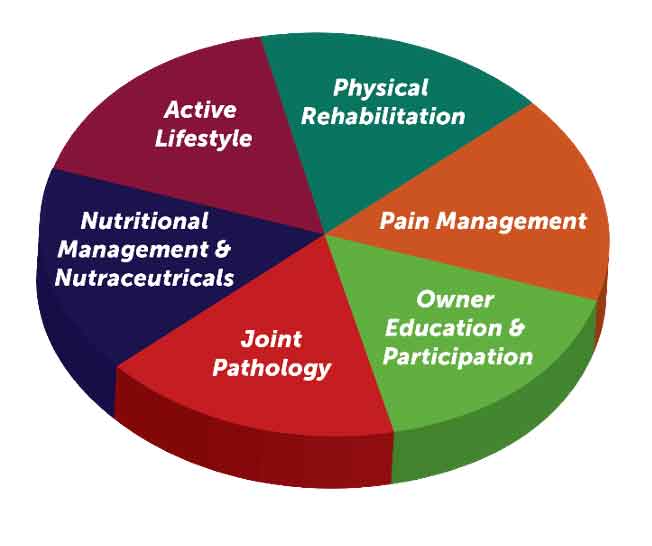26 Aug 2021
Canine OA and pet owners – what’s the message?
Ross Allan explains the need to inform, educate and inspire when discussing the diagnosis and management of cases with clients.

Image: © Viacheslav Lakobchuk / Adobe Stock

OA is a condition we frequently diagnose in practice, with studies suggesting up to 20% of dogs are affected.
But making the diagnosis is only the first step in treating OA effectively – it’s just the start.
Disease and client management are both areas in canine OA in which we have definite scope to improve patient function and comfort. This article will focus on client management, and specifically share tips for effective communication about diagnosis and management.
It will also outline the staged communication that the author uses when discussing OA with clients within the limitations of normal consults, and how he takes the “long view” to optimise OA disease management – making it a far more rewarding experience for vet, owner and, most importantly, patients.
Owner onboarding
Most owners’ default opinion when told their pet has OA is that it is degenerative, irreversible and only a disease of older dogs – this impression is wrong. And it’s the veterinary team’s responsibility to change the “image” of OA – a disease we know can be managed successfully.
As with any chronic disease, owner involvement and compliance with your recommendation is crucial to successfully treating pets with OA. This means real importance exists to “onboarding” the owner to what OA is and how best to manage it – starting from the time of initial diagnosis.
One key element of onboarding is the initial message at the time of diagnosis.
“OA, but he’s only five years old” is something we’ve all heard in practice, perhaps because we phrased the initial OA diagnosis poorly?
Instead, inform owners that “it’s common for many dogs to develop OA, even from a young age, but the good news is that if managed effectively we know a lot can be done to help minimise the impact this has on Alfie’s mobility and happiness: now and in the future”.
This is the message to get across – and in the author’s experience, the message owners need and want to hear.
OA: a dynamic disease
Another key message to get across to owners from the start is that OA is a “dynamic disease” – and while it will usually progress over a longer period, the good news is that flare-ups will usually settle down with effective treatment.
This discussion also helps provide the basis for introducing the concept of multimodal management:
“In acute flare-ups weight loss will not be of immediate benefit, while effective anti‑inflammatory pain management will be. Longer term, however, weight loss to optimise your pet’s weight is a really important area to focus on for many dogs.”
These are important messages to get across to owners.
Initial and ongoing response
The initial response to treatment for OA lameness and discomfort usually occurs within a week of starting effective treatment. Making sure to schedule a recheck appointment to follow up the progress of your patient – and taking time to review its progress and discuss its response – is important.
At this first recheck, it is important to celebrate the success of this initial response, but also caution that other flare-ups can occur. For this reason, the recheck appointment is usually a good opportunity to further explain the importance of longer-term multimodal OA management.
Multimodal OA management
Medical treatment is important for most dogs with OA, but non-medical strategies should not be neglected.
In the author’s experience, clients are very receptive to discussing the multimodal approach to managing OA at the time of initial diagnosis and follow-up appointments.
While describing every element at the time of the initial diagnosis is impractical, a mention of the multimodal concept at diagnosis is good – and future follow-up appointments are a good opportunity to further explain this concept to owners.
One multimodal system that has been described is outlined in Figure 1.

Involve clients in their pets’ treatment decisions and management plan
However simple some clinical treatment decisions can seem to us, it is essential to explain the options and involve clients in the treatment options chosen.
Being open when explaining the various treatment options, and the safety and efficacy of each, is far more likely to create a vet-client relationship built on trust, which is essential to effective care of all our patients – especially those with chronic disease.
Team approach
Managing chronic disease such as OA is more likely to be clinically rewarding if you can develop the principle of an “OA clinic” in your practice.
While the current changes in working due to COVID‑19 make this difficult, involving your team – such as nurses regarding weight/dietary modification, rehabilitation colleagues (internally or externally) and the reception team that helps you manage clients – will mean you can better facilitate effective multimodal management of OA.
However, the team “OA clinic” approach is not without a need for coordination and this is a different skill set to learn. So, start small, involve the team and learn as you go to help you learn how to collectively improve your OA management – go for it.
Regular rechecks – measure progress?
As with many chronic diseases it is important to regularly review the status of patients with OA. This is important clinically, but also demonstrates the philosophy the author would suggest is important to impart to owners – one of continuous OA management leading to a continuous improvement in OA status.
We are now able to evaluate progress in OA cases by using various measurement tools. These vary from clinical metrology instruments – such as Liverpool OA in Dogs (Walton et al, 2013); the Canine Brief Pain Inventory (Brown et al, 2008); the Helsinki Chronic Pain Index (Hielm‑Björkman et al, 2003) or Health‑Related Quality of Life (Reid et al, 2018) – which can act like a structured checklist to help score the impact OA is having on the patient. They yield a “score” that can be used to view progress at each visit.
Even simple filming of your patient walking, using a smartphone, and attaching the video to the patient’s records can help to more accurately review your patient’s progress and identify changes that have occurred since previous visits.
With correct planning, it is possible to use these tools as aids when reviewing OA patients. Dedicated clinics especially help enable the use of such resources in patients attending for ongoing management. Regular use will create a more streamlined and time‑efficient experience for the clinical team and pet owner.
Digital systems like Aim OA also have inbuilt disease tracking systems that can give a good visual representation of the real-time progress of OA and help understand the impact of OA management.
Summary – make a difference
Reviewing your patients’ response to the treatments you’ve advised is a key factor in all veterinary medicine. Therefore, from the time of initial consultation, be careful to:
- Inform the client of the true “dynamic” nature of canine OA.
- Educate him or her on the importance of an integrated multimodal OA management plan.
- Inspire him or her to learn more about his or her pet’s condition and join you in treating it effectively.
Getting these messages across to owners from the very start is key to effective management of OA.
Take ownership of your OA patients, join them on their OA journey and enjoy the satisfaction that comes from effective OA management.
References
- Brown DC, Boston RC, Coyne JC and Farrar JT (2008). Ability of the Canine Brief Pain Inventory to detect response to treatment in dogs with osteoarthritis, Journal of the American Veterinary Medical Association 233(8): 1,278-1,283.
- Hielm-Björkman AK, Kuusela E, Liman A et al (2003). Evaluation of methods for assessment of pain associated with chronic osteoarthritis in dogs, Journal of the American Veterinary Medical Association 222(11): 1,552-1,558.
- Palmer RH and Churchill J (2019). The keys to effective osteoarthritis management in small breed dogs, Zoetis, Proceedings from WSAVA Congress 2019, Toronto.
- Reid J, Wright A, Gober M et al (2018). Measuring chronic pain in osteoarthritic dogs treated long-term with carprofen, through its impact on health-related quality of life, Veterinary and Comparative Orthopaedics and Traumatology 31(S 01): A1-A6.
- Väre P, Nikiphorou E, Hannonen P and Sokka T (2016). Delivering a one-stop, integrated, and patient-centered service for patients with rheumatic diseases, SAGE Open Medicine 4: DOI: 10.1177/2050312116654404.
- Walton MB, Cowderoy E, Lascelles D and Innes JF (2013). Evaluation of construct and criterion validity for the ‘Liverpool Osteoarthritis in Dogs’ (LOAD) clinical metrology instrument and comparison to two other instruments, PLOS One 8(3): e58125.
